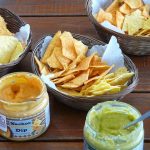Tortilla chips are a popular snack made from corn tortillas. The manufacture of tortilla chips typically involves several key steps.
- Ingredients Preparation:
- Corn: The primary ingredient in tortilla chips is corn or maize flour. The corn is typically washed and dried by the supplier before delivery to the manufacturer. The moisture content is around 14%. The corn is passed into large kettles containing almost-boiling water. These are then crushed and milled, then processed into masa, a dough-like mixture made by mixing corn with water and sometimes lime (calcium hydroxide) in a process called nixtamalization. Lime is used to soften the corn and improve its nutritional value. The corn masa is supplied usually in 900kg sacks.
- Masa Mixing:
- The masa is mixed to achieve the right consistency and texture. It should be smooth and free of lumps. It is mixed with sugar, salt and starch for a couple of hours with enough water to generate a thick claggy dough.
- Dough Formation:
- The masa having been shaped into a dough, is reduced from large balls to smaller amounts through a circular system of blades. The dough is now in smaller pieces ready for rolling. It is divided into small parcels of dough and conveyored so that a uniform quantity is supplied at all times. It is then flattened into one continuous thin sheet. This can be done using a machine called a “sheeter.”
- Cutting and Shaping:
- The thin sheets of masa are cut into the desired shapes for tortilla chips. This is typically done using a rotating circular or triangular cutter in the form of a concise mould. The cutter operates just like a cookie cutter. About 5% of the dough is not cut however it is returned to the dovats to begin being kneaded and cut again. Very little dough is lost. The chips are pressed out of the mould.
- Cooking:
- Once the chips are out of the mould, they are checked using a thickness monitor. Too thick and the chips wont bake or fry quickly enough. Too thin and they will burn under the extreme heat of the process. Achieving the right thickness is essential to achieving the best tortilla chip crunch after heating.
- The chips briefly spend some time in a baking oven to generate the golden-yellow colour and they don’t have to spend so long in the fryer. The chips are allowed to cool down for 5 minutes. A quality control step occurs here too – the chips are inspected to see if any have been burnt.
- The cut tortilla pieces are then cooked in hot oil for a minute at 175ºC until they become fully crispy and golden brown. The heating also curves and curls the crisps slightly. This process can be done through deep-frying or even further baking, depending on the desired texture and production method. Frying is always preferred.
- Seasoning:
- After cooking, the tortilla chips are typically seasoned with salt or various flavorings, depending on the desired taste. These chips are passed into rotating drum coaters which 1st contain some oil. The oil coating the chips allows flavour powder to stick to the chip. The flavouring usually contains salt too. Some common seasonings include chili powder, cheese powder, or lime zest. The flavourings are continually dosed into the rotating coater. Particular fittings within the drum scatter the coatings throughout the batch.
- Cooling:
- The hot, freshly cooked tortilla chips are then cooled down using air conveyors or similar cooling systems to bring them to room temperature.
- Packaging:
- Once cooled and seasoned, the tortilla chips are ready for packaging. They can be packaged in various types of containers, including bags, boxes, or even individual portion-sized packages.
- In many cases the tortilla chips are weighed precisely into a rolling cylinder of packaging in precise amounts.
- Quality Control:
- Throughout the manufacturing process, quality control measures are implemented to ensure that the chips meet specific standards for taste, texture, color, and size. Any chips that do not meet these standards are typically removed from the production line.
- Distribution:
- After packaging, the tortilla chips are ready for distribution to retailers, where they are made available to consumers.
The basic process we’ve described here for making tortilla chips remains relatively consistent. We’ve tried making them in the kitchen and some of the flavour variations are great. Why not try out the recipe for making the basic flavoured tortilla chips but also the special lime tortilla version too. You will have to accept there will be variations in recipes and production methods used by different manufacturers. Additionally, some tortilla chips are made using whole-grain corn, while others may use cornmeal or masa harina as the primary corn ingredient. The flavorings and seasonings used can also vary widely, leading to a wide range of flavours and styles of tortilla chips available in the market. What ever the level of variation it is a remarkably popular snack food which deserves exploration.


Leave a Reply